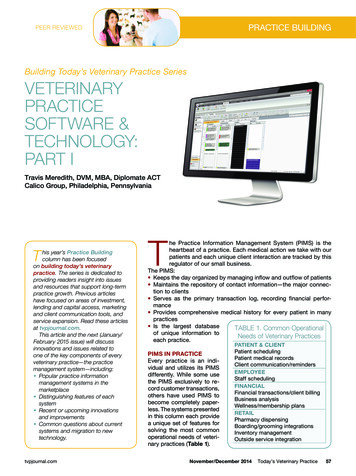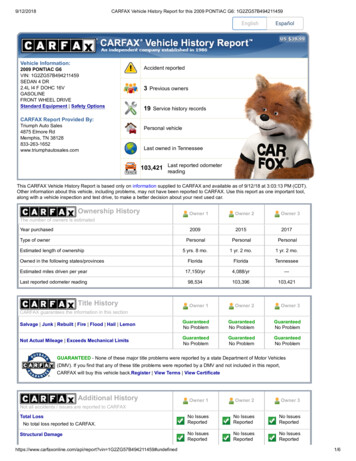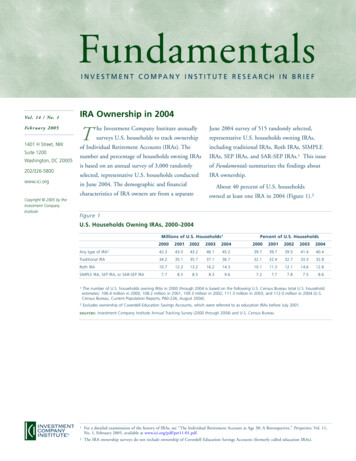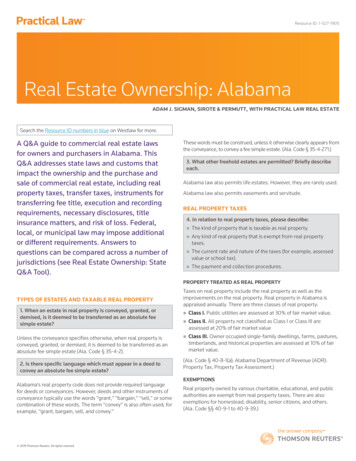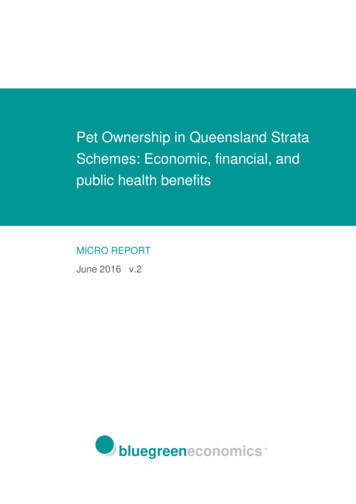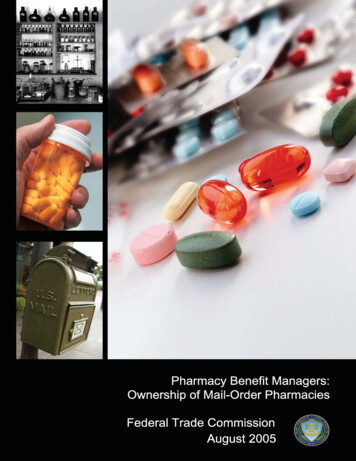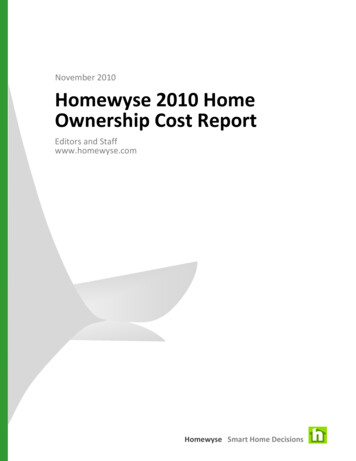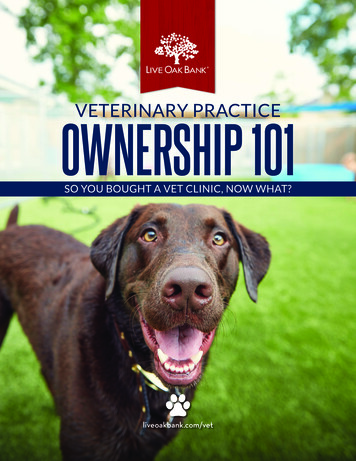
Transcription
VETERINARY PRACTICEOWNERSHIP 101SO YOU BOUGHT A VET CLINIC, NOW WHAT?liveoakbank.com/vet1
INTRODUCTIONAs a new practice owner, you will face some challenges you may not have anticipated. Havingfinanced over 770 veterinary practice acquisitions, we have been able to identify common themesand patterns that contribute to both successful and unsuccessful transitions.This resource will guide you through many of the decisions you must make and the responsibilities youwill assume, with the goal of putting you on the path to sucess.Recommendations are different just as each practice is different. These are ideas that can beimplemented if you chose to do so. We have found these methods useful with our current practiceowners. If you have any questions, please contact our veterinary team.SETTING GOALSSet realistic goals and, in your initial transition year, strive to achieve the following: Retention of the existing client base. A smooth transition with the seller. Revenue growth of 5-10%. Effective expense management with all non-doctor staffing costs at no more than 22% of gross annualrevenue and cost of goods sold at no greater than 22% of gross annual revenue. Being the leader in your practice and establishing a cohesive team that supports your practice mission. Growing your client base by securing at least 20 new clients per month for each full-time doctor inyour practice. Marketing your practice effectively, both online through your practice website and social media and bybecoming involved in your local community to achieve name recognition.THE EXISTING CLIENT BASETHE most valuable asset in your practice purchase is the existing client base. Retaining these clientsduring the transition in ownership and going forward is critical to your success.EXISTING CLIENT RETENTIONCommunicate effectively and often with the client base before, during and following your acquisition.2 If you are not already on staff and it is possible, work as a relief veterinarian in the practice you planon purchasing. Have the seller introduce you to existing clients and notify clients personally of yourimpending ownership. Increase your presence as much as possible in the time leading up to your acquisition. Have the seller post notices in the practice welcoming you on board. Have the seller send a letter to clients welcoming you to the practice and explaining the transition. Have the seller promote you on the practice website and through social media. Early in the transition, hold an open house with the seller in attendance to give clients the opportunityto meet you. Consider posting your cell phone number at the front desk and making yourself available for afterhours calls.
THE TRANSITION PLANHow can you best achieve a smooth transition into your newly acquired practice? During the transition phase and for at least six months thereafter, you should consider adopting theexisting practice “personality.” To hold on to existing clients, it is essential to maintain familiarity at the practice. Give clients time to accept the change in ownership and come to appreciate your personality and thepractice culture you wish to develop. Remain accessible to existing clients so they know you will be there for them and their pets. Keeping the seller on staff for a time after your acquisition also can help maintain an elementof familiarity. If the seller does not stay on board, it still remains crucial to ensure an amicable relationship with theseller. This is especially true if the seller remains in the community, as a poor relationship will have anegative impact on your practice. If the seller does remain on board, can you afford it? Keeping the seller in the practice will add to youroverall staffing expense. How long will the seller stay, and will he or she work full or part time?IMPLEMENTING CHANGE IN THE PRACTICEConsider avoiding significant change during the first six months of ownership. Thereafter, make changesgradually. Identify areas within the practice where changes may be required, such as the servicesprovided, the fee structure, the quality of care, practice operations and facility aesthetics. The keys toimplementing some of these changes effectively: obtain team input, set clear protocols and standards,hold regular team meetings (at least monthly) and provide team training where indicated.TIME MANAGEMENTHow many hours a week will you need to work to practice veterinary medicine and manage ahospital effectively? Keep in mind that you may be required to work in excess of 50 hours a week in your first several yearsof ownership. You may spend a great deal more time on practice management than you anticipated. Ten or morehours a week may need to be devoted to management tasks. What hospital hours do you plan to keep, and how do you plan to organize your work day? We recommend monthly budget projections for the remainder of your practice year, then setting acomplete budget for the upcoming year. Promote client convenience by offering extended and weekend hours. Do not close over the lunch hour. Maximize appointment availability by seeing appointments every 20 minutes or scheduling brief andextended examination slots.3
SETTING A BUDGETYou will need to set a budget. Without a proper budget, you may over spend in important expense categories such as inventory andstaffing. “Benchmarks 2015: A Study of Well-Managed Practices” (Benchmarks 2015)* contains guidelines forexpense management. This example can serve as a guide. (See page 13.) Your Live Oak Bank Business Advisory Group team member can assist you with budgeting. If you have retained an accountant and/or a practice management consultant, consult with him or herregarding appropriate budgeting. The value of setting a budget will be more apparent in future years when you can compare actualresults with your projections. You will appreciate the ability to look back at prior years’ results to guideyou in managing your practice going forward.PREPARING AND REVIEWING FINANCIAL STATEMENTSThe basic financial statements you will need to create include a Statement of Income and Expenses(Profit and Loss Statement) and a Statement of Assets and Liabilities (Balance Sheet). To see a sampleProfit & Loss Statement, refer to the example on page 13.If you do create your own financial statements, you may find it easiest to use QuickBooks. Depending on your proficiency with QuickBooks, you may need to spend 5-10 hours a month trackingyour income and expenses and entering this information into QuickBooks. Consider taking a course to gain familiarity with QuickBooks.Visit ter/documents/ to get a copy of“Quickbooks: Making it Work for your Practice.”If you can afford one, you may wish to hire an accountant to handle your financial statements. You mayhave to budget up to 0.5% of gross annual revenue toward accounting services. Depending on the sizeof your practice ( 900,000) in annual revenue, you may want to consider an industry specialist, but hisor her services could be more costly.You may want to hire a practice manager to assist you with financial management. Be sure you can afford one. Compensation for a practice manager can cost you 4% or more of grossannual revenue and could strain your staffing budget. Your practice manager should be adept at creating and reviewing financial statements.You may wish to retain a veterinary industry consultant to assist you with creating your financialstatements and reviewing your financial picture. Data from Benchmarks 2015* suggests that “wellmanaged” practices spend an average of 0.4% of gross revenue on business consultation services.You will need to ensure you provide Live Oak Bank with quarterly financial statements and tax returnseach year. Not only does this help us, we can provide you with valuable feedback on your financialperformance after reviewing the required documentation.*“Benchmarks 2015: A Study of Well-Managed Practices” can be found online at www.industrymatter.com.4
PRACTICE MANAGEMENT Practice Management Software: Benefits and Uses Revenue: Fees and Pricing/The Average Transaction Charge Expense Management: Inventory Management/Staffing and Labor Growing Your Practice: Providing a Great Client ExperienceUSING PRACTICE MANAGEMENT SOFTWAREPractice management software can improve the efficiency of your practice and help you trackpractice performance. Many practices have become paperless or “paper-light.” Your software can help ensure that services provided are tracked more accurately. Some practices are now using cloud-based software, and you may wish to consider this option.Practice management software can be used to: Manage inventory Schedule appointments and manage daily work flow Create and maintain patient records Record services provided Access patient diagnostics Provide client educationBe certain you and your team are proficient at utilizing all the tools your practice managementsoftware offers. If you are unfamiliar with the software used by the practice you have acquired or install new software,immediately take a course and gain familiarity with the system. The software cannot be an aid in practice management if you and your team members are notcomfortable using it.5
REVENUETrack your gross revenue on a weekly, monthly and quarterly basis. Successful practices see about 500,000 in annual revenue per full time doctor in the practice.Review your average transaction charge daily, weekly and monthly. This number is the average of all invoices for doctor-associated patient visits and generally does notinclude over the counter purchases such as medication refills or prescription diets. If the average transaction charge is not 3.5 to 4 times your office examination fee, explore why. Areyour fees set appropriately? Are you discounting, giving away services or missing charges? Are you andyour staff struggling to gain client compliance with your recommendations?On a monthly basis, review the number of active clients in your data base, the number of patient visits,client retention statistics and the average number of visits per client. If you see negative trends, try todetermine why and seek capable advice to help you correct your numbers.Every week, look at the number of new clients you gained. For example, you should strive to see about 20-25 new clients per month for each full time doctorin the practice. If you are not securing enough new clients, you may need to re-think your marketingstrategy. If you review this information regularly, you can make adjustments.Focus on driving revenue through providing medical and surgical services. Benchmarks 2015* reports that “well-managed” practices derive less than 33% of gross revenue fromthe sale of medical products, over the counter products, pet diets, preventatives and boarding andgrooming services. Due to increasing competition from providers such as PetMeds and warehouse stores, these sales willcontinue to represent less of the revenue “pie” for veterinary practices. You might consider offering your own online pharmacy on your practice website. This may be moreconvenient for your clients and should help you reduce inventory expense.PRICING AND FEESA proper fee structure is the backbone of practice revenue and will be essential for your financial success.Consider setting fees for commonly “shopped” services, such as vaccines and exams, competitively withlike providers in your community. Make a list of “shopped” services including the examination charge, all canine and feline vaccines,intestinal parasite screening, deworming, heartworm testing, and canine and feline OHEs and neuters.Have friends and family members “mystery shop” for you. They can ask many of the same questionsyour staff members field when phone shoppers call your practice.Don’t set your fees for the remainder of your services randomly. Use resources such as Benchmarks 2015* and the AAHA Veterinary Fee Reference 9th Ed.) forguidelines or hire a consultant who specializes in proper fee setting to assist you.Be sure to mark-up prescribed medications, injectable medications, preventive care products,laboratory services, diets and over-the-counter products appropriately. Mark-ups generally are between2 and 3 times your cost.You may need to avoid increasing existing fees for up to six months after assuming ownership tomaintain continuity. 6If you need to increase fees, do so slowly. Start with no more than a 2.5% increase to test for resistancefrom the existing client base.
EXPENSE MANAGEMENTTo insure your financial success, it is critical that you manage two major expense categories very well:cost of goods sold (COGS) and your staffing expenses. In fact, if these costs get out of hand, you couldexperience significant financial stress.COGS and staffing expenses will be by far your greatest costs and, unlike fixed expenses such as rent,YOU CAN CONTROL THEM!If you do a good job of managing these expenses, you likely will see greater personal compensationfrom your practice.MANAGING YOUR COST OF GOODS SOLDCOGS should not exceed 20-22% of your gross revenue. EXCESS INVENTORY EQUALS NONPERFORMING CASH ON YOUR SHELVES.COGS includes: Medical supplies and drugs Laboratory expenses Over the counter items such as pettreats and toysPreventatives such as flea and tickcontrol and heartworm prevention Radiology expenses Medical waste disposal costsPet’s diets Cremation/animal disposal costsTake an initial inventory count and carefully enter those figures in the inventory management toolavailable in your practice management software. Set a budget for weekly inventory purchases. A goodrule of thumb is that your weekly order should total no more than 12% – 14% of the gross revenue fromthe preceding week. Set reorder points so you keep only a 15-30 day supply of most items on hand. Try not to carry duplicates of products such as heartworm prevention and prescription diets. Do not be tempted to buy in bulk because vendors offer attractive “new owner” discounts. The vendorsare shifting their carrying costs to you. Research online pharmacy providers and consider linking one to your practice website. An onlinepharmacy may help you better manage inventory costs.MANAGING YOUR STAFFING COSTSTotal non-doctor staffing costs should not exceed 24% of gross revenue. Benchmarks 2015* reportsthat “well-managed” practices spend approximately 21% of gross revenue on non-doctor staff wagesand another 2.3% on staff payroll taxes. Employee benefits could drive up your labor costs even more. To best manage your non-doctor staffing costs, try to work with only three employees supporting you:a receptionist and two veterinary technicians/assistants. Compensate your staff at wages commensurate with their expertise, experience and the prevailingwage in the community. If you have an associate doctor in your practice, consider that doctors compensated on a productionbasis commonly receive 20-22% of the medical revenue they generate and less than 10% onproduct sales.*“Benchmarks 2015: A Study of Well-Managed Practices” can be found online at www.industrymatter.com.7
GROWING YOUR PRACTICETo retain your existing client base and bring in new clients, you will need to provide a great clientexperience and market your practice well. Your front desk and reception area is where clients form theirfirst impressions of your practice. Client areas should be clean and odor free.The reception area should promote your services. Consider featuring a TV running informative content and keep current client educational materialsreadily available. Your front desk team should be courteous and knowledgeable, and your staff should be trained toanswer common client questions, educate your clients and recommend your services. Give your team the tools to provide exceptional client service and help you educate your clients.Consider subscribing to training modules available through services such as Animal CareTechnologies or On the Floor @ Dove or use free webinars available on the VetMedTeam andIDEXX Learning Center websites.Your team should become comfortable converting “phone shoppers” into new clients. Have your staff engage the caller and learn about the caller’s pet and the services the caller is seekingbefore discussing pricing. If the caller will not schedule an appointment, offer the caller a hospital tour.Your front desk team should help you retain clients.8 Your staff should always schedule recheck appointments at check-out when appropriate. They should obtain current client contact information, including an e-mail address, for use in sendingreminders, offering specials and communicating with clients in the future. Use your front desk team to help you track new client sources. Increase referrals from existing clients by offering a referral reward program.Give your clients a credit on their accounts for every new client they refer to you with no limit on thenumber of referrals.
MARKETINGThe “well-managed” practices examined in Benchmarks 2015* spend roughly 0.8% of total annualrevenue on marketing. Marketing tools you should employ include: A practice website The use of social media such as Facebook Community outreach and involvement Email communications such as an e-newsletter A reminder system offering text and email reminders and client satisfaction surveysAs a new practice owner, you may be approached by firms selling “yellow book” or similar advertising.Our experience suggests this is not an effective marketing tool particularly given the high cost.THE PRACTICE WEBSITEA solid website is essential to market your practice effectively. Does the practice you have acquiredhave a website? If so, you may need to shut the site down at the appropriate time or rebuild/replaceit. You may also want to consider keeping the existing website functional for a time if the seller ispromoting you in the practice transition.The practice website should: Clearly state the practice mission with a focus on the human/animal bond. Let potential clients get to know you with personalized staff bios featuring photos with pets. Promote and explain your services. Provide a virtual tour of the practice featuring staff members and pets. Allow you to communicate with your clients through a Blog. Allow clients to access pet records and schedule appointments. Offer an online pharmacy if you chose to feature one.Your website should have good SEO (search engine optimization). A great website cannot help you if noone can find it!The following tips will help you achieve good SEO: Optimize your page titles - adding meta titles to your pages is the first thing you should do. Yourwebsite administrator should be able to assist with this effort. Claim your business on Yelp, Google, Yahoo and Bing local pages. Create interesting content for your website using rich media (videos and & images).You may need professional assistance developing and maintaining a good practice website; or anindustry specialist may be best.*“Benchmarks 2015: A Study of Well-Managed Practices” can be found online at www.industrymatter.com.9
SOCIAL MEDIAYou should start and maintain a practice Facebook page. While social media is a mostly free resourceand can be effective, we encourage you to use your best judgement in determining how much time isallotted to this medium.Keep in mind the following when promoting your practice on Facebook: Posts to the Facebook page should appear a minimum of three times per week and should stay current. The content should be engaging and informative. The page should educate clients and promote your services. The page can serve as a tool to network with pet-related businesses and organizations. The page can keep clients abreast of current events in your practice. You can use the page to offer discounts and specials. Activity on your Facebook page can improve SEO for your practice online. The page should be maintained by a responsible party such as a capable staff mem
Practice management software can be used to: Manage inventory Schedule appointments and manage daily work flow Create and maintain patient records Record services provided Access patient diagnostics Provide client education Be certain you and your team are profi

